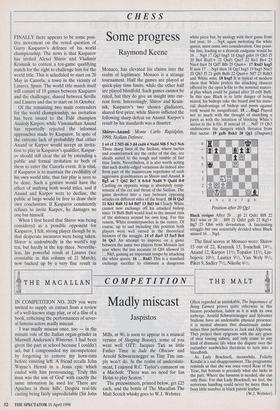CHESS
Some progress
Raymond Keene
FINALLY there appears to be some posi- tive movement on the vexed question of Garry Kasparov's defence of his world championship. The news is that Kasparov has invited Alexei Shirov and Vladimir Kramnik to contest a ten-game qualifying match for the right to challenge him for the world title. This is scheduled to start on 20 May in Cazorla, a town in the vicinity of Linares, Spain. The world title match itself will consist of 18 games between Kasparov and the challenger, shared between Seville and Linares and due to start on 16 October.
Of the remaining two main contenders for the world championship, no invitation has been issued to the Fide champion Anatoly Karpov, while Viswanathan Anand has reportedly rejected the informal approaches made by Kasparov. In spite of the extreme lack of probability that either Anand or Karpov would accept an invita- tion to play in Kasparov's qualifier, Kaspar- ov should still clear the air by extending a public and formal invitation to both of them to enter the Cazorla event. It is vital, if Kasparov is to maintain the credibility of his own world title, that fair play is seen to be done. Such a gesture would have the effect of unifying both world titles, and if Anand and Karpov were to decline, the public at large would be free to draw their own conclusions. If Kasparov consistently refuses to invite Karpov, he damages no one but himself.
When I first heard that Shirov was being considered as a possible opponent for Kasparov, I felt, strong player though he is, that desperate measures were being taken. Shirov is undoubtedly in the world's top ten, but hardly in the top three. Neverthe- less, his powerful result at Linares (see crosstable in this column of 21 March), now backed up by a very fine result in Monaco, has elevated his claims into the realm of legitimacy. Monaco is a strange tournament. Half the games are played at quick-play time limits, while the other half are played blindfold. Such games cannot be rated, but they do give an insight into cur- rent form. Interestingly, Shirov and Kram- nik, Kasparov's two chosen gladiators, shared first prize, while Shirov inflicted the following sharp defeat on Anand. Karpov's result by his standards was a disaster.
Shirov–Anand: Monte Carlo Rapidplay, 1998; Sicilian Defence.
1 e4 c5 2 Nf3 d6 3 d4 cxd4 4 Nxd4 Nf6 5 Nc3 Nc6 These sharp lines of the Sicilian, where tactics and counterattack are the order of the day, are ideally suited to the rough and tumble of fast time limits. Nevertheless, it is also worth noting that such double-edged variations do indeed also form part of the mainstream repertoire of such aggressive grandmasters as Shirov and Anand. 6 Bg5 e6 7 Qd2 Bel 8 0-0-0 Nxd4 9 Qxd4 0-0 Castling on opposite wings is absolutely symp- tomatic of the cut and thrust of the Sicilian. The game devolves into a race between opposing attacks on different sides of the board. 10 f4 Qa5 11 Kbl Rd8 12 h4 Bd7 13 Bd3 h6 Clearly White cannot now exchange off his attacked bishop since 14 Bxf6 Bxf6 would lead to the instant ruin of the defences around his own king. For this reason, White counterpunches in the centre. Of course, up to and including this position both players were well versed in the theoretical nuances of the struggle. 14 e5 dxe5 15 fxe5 Bc6 16 Qe3 An attempt to improve on a game between the same two players from Monaco last year where the less accurate 16 Of4 allowed 16 ...Nh5, gaining an important tempo by attacking the white queen. 16 ...Rxd3 This is a standard exchange sacrifice to eliminate a dangerous white piece but, by analogy with their game from last year, 16 ... Ng4, again molesting the white queen, must come into consideration. One possi- ble line, leading to a drawish endgame would be 16 ...Ng4 17 0g3 hxg5 18 Qxg4 gxh4 19 Qh5 f5 20 Bc4 Rxdl+ 21 Qxdl Qxe5 22 Rel Be4 23 Nxe4 fxe4 24 Qd7 Bf6 25 Qxe6+. 17 Rxd3 hxg5 If now 17 ...Ng4 then 18 Qg3 hxg5 19 hxg5 Nxe5 20 Qh3 f5 21 gxf6 Bxf6 22 Qxe6+ Nf7 23 Rdh3 and White wins. 18 hxg5 It is typical of modern chess that White prefers the attacking chances offered by the open h-file to the nominal materi- al plus which could be gained after 18 exf6 Bxf6. In this case Black is in little danger of being mated, his bishops rake the board and his mate- rial disadvantage of bishop and pawn against rook would be insignificant. 18 ...Bxg2 Played not so much with the thought of snatching a pawn as with the intention of blocking White's access to the h-file. If instead 18 ... Nd5 19 Qh3 underscores the dangers which threaten from that sector. 19 gxf6 Bxhl 20 Qgl (Diagram) Position after 20 Qgl
Black resigns After 20 ...g6 21 Qxhl Bf8 22 Rh3 wins or 20 ...Bf8 21 Qxhl gxf6 22 Rg3+ Bg7 23 Qh6 with devastation. A fascinating struggle but one essentially decided when Black missed 16 Ng4.
The final scores at Monaco were: Shirov 15 out of 22, Kramnik 15, Ivanchuk 141/2, Anand 12, Karpov 111/2, Topalov 111/2, Lju- bojevic 101/2, Lautier 91/2, Van Wely 91/2, Piket 9, Sadler 71/2, Nikolic 61/2.


























































 Previous page
Previous page